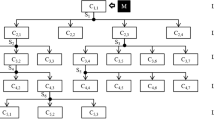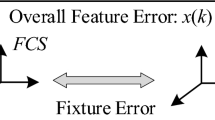Abstract
Sensor deployment to robustly monitor operation parameters is the cornerstone for timely diagnosing variations that lead to product quality defects. A sensor system with optimal placement can help manufacturers improve product quality and reduce process downtime. However, current literature lacks investigation in methodologies that consider the mechanism of variation propagation, heterogeneity among sensor and variation properties, and multi-objective optimization involved in the sensor layout for variation diagnosis in an assembly process. In our approach, sensing information from fixture error and part machining error is integrated into a step-indexed state space model based on an understanding of variation propagation mechanism for the stream of assembly set variation described in a single-station multi-step assembly process. The effectiveness of such sensor system is quantified by some indexes, which are used to quantitatively characterize the diagnosability. Based on digraph theory, a quantitative fuzzy binary graph-based approach is developed to model the cause–effect relationship between part variations and sensor measurements considering the heterogeneous properties of sensor and variation, thus an improved shuffled frog-leaping algorithm is proposed to determine the sensor types, numbers, and locations to achieve full diagnosability. An example for the differential assembly illustrates the methodology.
Similar content being viewed by others
References
Khan A, Ceglarek D (2000) Sensor optimization for fault diagnosis in multi-fixture assembly systems with distributed sensing. J Manuf Sci E T ASME 122(1):215–226
Ding Y, Kim P, Ceglarek D, Jin J (2003) Optimal sensor distribution for variation diagnosis in multistation assembly processes. IEEE T Robot Autom 19(4):543–556
Jeong W, Ko H, Lim H, Nof S (2013) A protocol for processing interfered data in facility sensor networks. Int J Adv Manuf Technol 67(9–12):2377–2385
Mandroli SS, Shrivastava AK, Ding Y (2006) A survey of inspection strategy and sensor distribution studies in discrete-part manufacturing processes. IIE Trans 38(4):309–328
Ceglarek D, Ni J (1998) Sensor location optimization for fault diagnosis in multi-fixture assembly systems. J Manuf Sci E T ASME 120(4):781–792
Issa M, Petkovic D, Pavlovic ND, Zentner L (2013) Sensor elements made of conductive silicone rubber for passively compliant gripper. Int J Adv Manuf Technol 69(5–8):1527–1536
Galetto M, Mastrogiacomo L, Pralio B (2011) MScMS-II: an innovative IR-based indoor coordinate measuring system for large-scale metrology applications. Int J Adv Manuf Technol 52(1):291–302
Liu Y, Jin S (2013) Application of Bayesian networks for diagnostics in the assembly process by considering small measurement data sets. Int J Adv Manuf Technol 65(9–12):1229–1237
J-w S, L-f X, Pan E-s, S-c D, T-b X (2009) Design for diagnosability of multistation manufacturing systems based on sensor allocation optimization. Comput Ind 60(7):501–509
Ren Y, Ding Y (2009) Optimal sensor distribution in multi-station assembly processes for maximal variance detection capability. IIE Trans 41(9):804–818
Li J, Jin J (2010) Optimal sensor allocation by integrating causal models and set-covering algorithms. IIE Trans 42(8):564–576
Liu K, Shi J (2013) Objective-oriented optimal sensor allocation strategy for process monitoring and diagnosis by multivariate analysis in a Bayesian network. IIE Trans 45(6):630–643
Shukla N, Ceglarek D, Tiwari MK (2015) Key characteristics-based sensor distribution in multi-station assembly processes. J Intell Manuf 26(1):43–58
Abellan-Nebot JV, Liu J, Subirón FR (2012) Quality prediction and compensation in multi-station machining processes using sensor-based fixtures. Robot Comput Integr Manuf 28(2):208–219
Zhigang Y, Huijun Z, Shengze W, Weizhong G, Song H (2004) The establishment and reasoning of knowledge base system for mechanism kinematic schemes. Int J Adv Manuf Technol 23(3–4):295–300
Yajun J, Zhenliang L (2006) Knowledge induction from uncertain information systems. Int J Adv Manuf Technol 30(7):769–777
Venkatasubramanian V, Rengaswamy R, Yin K, Kavuri SN (2003) A review of process fault detection and diagnosis: part I: quantitative model-based methods. Comput Chem Eng 27(3):293–311
Bhushan M, Rengaswamy R (2002) Comprehensive design of a sensor network for chemical plants based on various diagnosability and reliability criteria. 1. Framework. Ind Eng Chem Res 41(7):1826–1839
Wu Z, Hsieh S-J, Li J (2013) Sensor deployment based on fuzzy graph considering heterogeneity and multiple-objectives to diagnose manufacturing system. Robot Comput Integr Manuf 29(1):192–208
Shi J, Ceglarek D (2002) Diagnosability analysis of multi-station manufacturing processes. Ann Arbor 1001:48109
Shi J (1999) State space modeling of sheet metal assembly for dimensional control. Ann Arbor 1050:48109–42117
Chen Y, Jin J, Shi J (2004) Integration of dimensional quality and locator reliability in design and evaluation of multi-station body-in-white assembly processes. IIE Trans 36(9):827–839
Chen W, Ni L, Xue J (2008) Deformation control through fixture layout design and clamping force optimization. Int J Adv Manuf Technol 38(9):860–867
Ding Y, Ceglarek D, Shi J (2002) Fault diagnosis of multistage manufacturing processes by using state space approach. J Manuf Sci E T ASME 124(2):313–322
Behnamian J, Ghomi SF, Zandieh M (2014) Realistic variant of just-in-time flowshop scheduling: integration of Lp-metric method in PSO-like algorithm. Int J Adv Manuf Technol 75(9–12):1787–1797
De Mast J, Lokkerbol J (2012) An analysis of the Six Sigma DMAIC method from the perspective of problem solving. Int J Prod Econ 139(2):604–614
Rezaee MJ, Salimi A, Yousefi S (2017) Identifying and managing failures in stone processing industry using cost-based FMEA. Int J Adv Manuf Technol 88(9–12):3329–3342
Raghuraj R, Bhushan M, Rengaswamy R (1999) Locating sensors in complex chemical plants based on fault diagnostic observability criteria. AICHE J 45(2):310–322
Coello CC (2006) Evolutionary multi-objective optimization: a historical view of the field. IEEE Comput Intell Mag 1(1):28–36
Eusuff M, Lansey K, Pasha F (2006) Shuffled frog-leaping algorithm: a memetic meta-heuristic for discrete optimization. Eng Optim 38(2):129–154
Edan Y, Nof SY (2000) Sensor economy principles and selection procedures. IIE Trans 32(3):195–203
Acknowledgments
The authors would like to thank the National Natural Science Foundation of China (no. 51075070), the Natural Science Foundation of Anhui Province (no.1708085ME104), the Suzhou Univ. Professor (PhD) Scientific Research Foundation (no.2016JB09), and the Key Project of Natural Science Foundation of Universities of Anhui Province (no. KJ2017A439, KJ2016A803).
Author information
Authors and Affiliations
Corresponding author
Rights and permissions
About this article
Cite this article
He, K., Jia, M., Zhu, L. et al. Sensor deployment for variation diagnosis considering heterogeneity in single-station multi-step assembly processes. Int J Adv Manuf Technol 94, 3889–3901 (2018). https://doi.org/10.1007/s00170-017-1083-6
Received:
Accepted:
Published:
Issue Date:
DOI: https://doi.org/10.1007/s00170-017-1083-6




